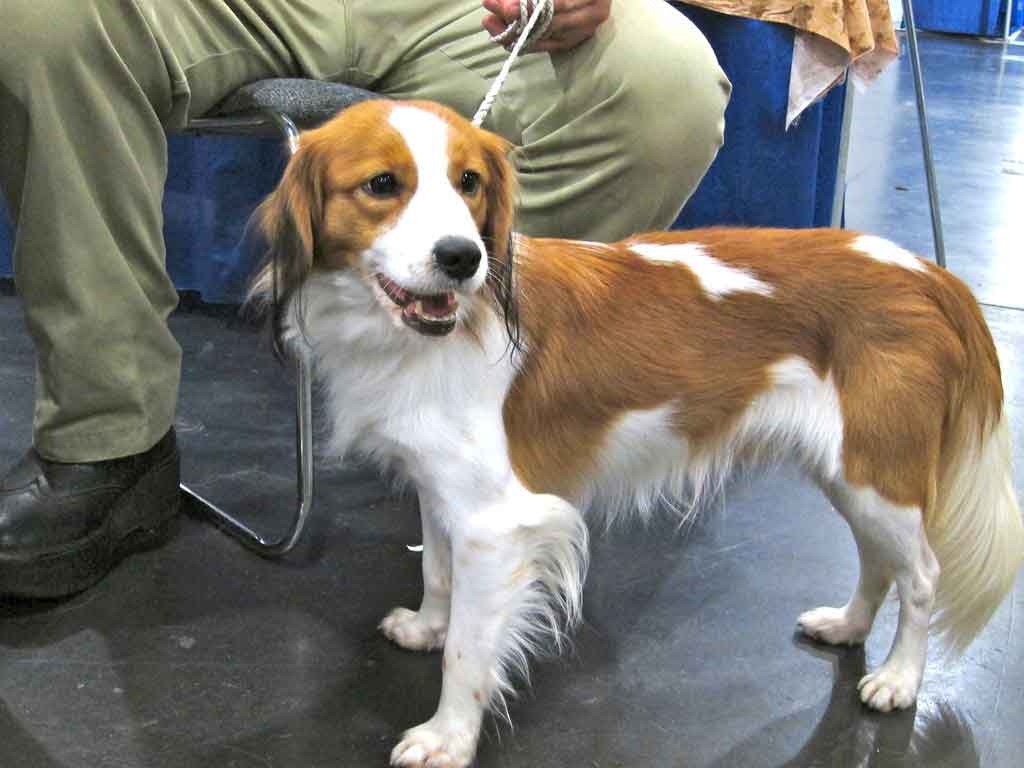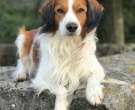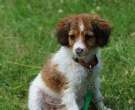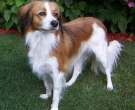Content |
|---|
History
This puppy with an unpronounceable original name has a long history, that begins in the Middle Ages, more specifically in the fifteenth century, when the Spanish brought the first Spaniels to the Netherlands. Several crosses with local dogs resulted in the Kooikerhondje (Kooiker). The dog quickly spread, appearing in many paintings by 17th century Dutch masters, como Jan Steen (1626-1679), but also in literature, especially in the Dutch Historian Stories Pieter Corneliszoon Hooft (1581-1647).
It was his special talent for hunting ducks that made him famous. Dutch for "small cager dog" (other name of Kooikerhondje – Kooiker). He was trained to lure ducks with his white plumed tail into trapped channels that ended in a cage (“eendenkooi“, in Dutch), where the hunters (“kooiker“) they could catch them easily. The specimens used for this hunting technique were called “hondjes de Kooiker“, and the name has remained in this breed.
Apart from the Kooikerhondje (Kooiker), few breeds are capable of learning this hunting technique. A notable exception is the Nova Scotia Duck Tolling Retriever, which appeared in the 19th century and is generally considered to be a descendant of the Kooiker.
But, the usefulness of the dog did not end there: when it wasn't duck hunting season, it was used to hunt vermin.
Its population declined rapidly between the two wars, mainly due to the abandonment of this hunting method (which required a lot of work to keep the channels from the traps) in favor of the use of the rifle, facilitated by the greater precision of firearms. Like this, on the eve of World War II, the breed had almost disappeared, with a total number of individuals estimated at only thirty.
After the invasion of the Netherlands in 1940, the baronessa von Hardenbroek of Ammerstol, in the spirit of resistance to the German occupation, decided to save this typically dutch dog. Delivered a black and white photo to several street vendors, asking them to notify you if they encountered such an animal. That's how he found Tommy, a female Kooiker from the North of the Netherlands, which was the reason for the rebirth of the breed as we know it today.
Among 1942 and 1976, the baroness raised 52 layers of Dutch foxhounds that were named after his kennel, from Valhalla, and obtained the recognition of the breed by the Raad van Beheer (the official canine organization of the country) in 1971. Later, the breed was recognized by the Fédération Cynologique Internationale (FCI) in 1990 and by the United Kennel Club (UKC) American in 1996. The other leading American organization, the American Kennel Club (AKC), did the same in 2004.
If he Kooikerhondje (Kooiker) has become a relatively common dog in its country of origin, not yet the case in the rest of the world, where remains unknown. But, things seem to be changing since the decade of 2010.
Like this, en el Reino Unido, where it is recognized by The Kennel Club, Enrollments have increased considerably since 2013, to the point of already exceeding fifty copies a year.
Also in France there is a certain madness for this breed: while in 2007 and 2012 they only signed up 5 specimens in the LOF (French Origin Book), between 2013 and 2018 there were more than 200.
In United States, the Dutch for "small cager dog" still very weird, but the Dutch Kooikerhondje Club of America (NKCUSA) registered 11 new breeders in 2018 and 2019, suggesting that the breed is also enjoying growing interest there, and that its population will increase rapidly.
Photo: Kooikerhondje puppy by Petful
Physical characteristics
The Kooikerhondje – Kooikerhondje is a medium-sized dog with a harmonious build, with a general appearance reminiscent of a Spaniel. Her body, slightly longer than tall, he is muscular but thin: they are dogs made for speed and agility. The tail follows the line of the back and reinforces its slender appearance.
The head is carried high, which gives it an aristocratic air. The skull is quite wide and rounded, while the muzzle, ending in a black nose, is slightly truncated. His dark brown almond eyes express intelligence and kindness. The ears are medium in size, placed in a line that starts from the nose and passes through the eye, falling down the cheeks.
The coat is of medium length and can be smooth or slightly wavy. The legs have a longer plumage on the hind legs than on the front ones., but it is the plumage of the tail that is most characteristic of the Kooikerhondje: long and white, giving the tail a feathery look. The long black hairs on the tips of the ears, known as “slopes”, they are highly sought after.
The coat is predominantly white, with large well-marked orange-red spots on the body. The rule Kooiker accepts small marks of this color on the legs, as well as the presence of some black hairs mixed with the red-orange color. The head must have a clear white line that reaches the nose.
Sexual dimorphism is moderately marked, the male being slightly larger than the female, that tends to shed more hair during the shedding period.
▷ Male size: 38 – 42 cm.
▷ female size: 36 – 40 cm.
▷ Male weight: 10 – 13 kg.
▷ female weight: 9 – 12 kg.
Character and skills
The Kooikerhondje It is a loyal dog, very attached to his family, from which he does not like to part. But, they are not effusive and prefer to stay quietly by their master's side rather than jump up to show their attachment. You also need a quiet environment, and does not bear stress well: parties or frequent quarrels would risk lasting disturbance.
Logically, not a recommended breed of dog for young children, since the cries of a baby or the whims of a small child are hardly to his taste. They are much better suited to a family that shares their calm and relaxed approach to life..
They are quite suspicious of people they do not know, but they quickly accept those who pay them a little attention, especially if they take the trouble to offer them a reward.
Although it accepts other dogs of a similar character, does not particularly seek the company of other dogs. Regarding coexistence with other animals, especially with cats or rodents, can be especially difficult due to its strong hunting instinct. Even if he is able to get along with the household animals he has been raised with, the risk that one day he will start chasing the family cat is very real.
If his placid character could make him suitable for the elderly, he forgets a bit quickly that he is also very active, needing at least two hours of exercise a day. Having said that, he is not very demanding with what he does, and is just as likely to accompany its owner on a long, leisurely walk as it is to chase a ball with the children in the garden or fetch it. But, prefers water activities: to swim, jumping into the water or just playing in a pond are activities that make this water-loving dog happy, since he was originally bred to work on the canals.
If you can live in an apartment as long as your daily need for activity is met, the Kooikerhondje he greatly prefers having a garden in which to frolic. But, you need to make sure the space is well fenced because, even if I do not have a special predisposition to flee, his hunting instinct is likely to push him to run after all the animals in the region and, Therefore, to move away from your residence.
In any case, although it is generally calm, problems can arise if you don't get a chance to expend your energy and are left alone too often. In particular, the owner may face inopportune barking and / or destructive dog behavior.
Smart and attentive, to the Kooikerhondje he likes to be stimulated intellectually; they especially like obedience exercises or learning new tricks. But, your intelligence is a double-edged sword, as they quickly pick up on any hesitation on the part of their master, and they can decide to assume the leadership of the family pack. So, It is a breed reserved for a master who already has experience, in addition to being able to provide you with the stable environment you need.
Education
Like all dogs, the Kooiker needs to be socialized from a young age to get used to people, places, noises, smells… that you will know during your life. It is especially advisable to introduce the small animals that share your home as soon as possible, to minimize the risk of lawsuits or even accidents once you are an adult.
The Kooikerhondje, very sensible, reacts poorly to stressful situations and can be traumatized by traditional training methods. So, their training should be based on positive reinforcement: the compliments, accompanied by caresses and some sweets, they work much better than reprimands. But, your teacher must stand firm and consistent, so as not to confuse you and make you lose confidence in your leader's ability to lead.
It is important that all family members are involved in their education, to assimilate and accept your authority.
Active, smart and eager to please, the Kooikerhondje It is an ideal student for obedience exercises as well as for learning different dog sports.: flyball, agility, dogs-cross…
Health
The Kooiker has a small gene pool and, Therefore, is prone to many life-threatening genetic diseases. Fortunately, the work of selecting the breeders responsible for Kooiker has resulted in the practical elimination of these risks today.
These diseases with which the breed has often been associated are:
Another risk to the health of the Dutch for "small cager dog" is obesity, so the owner should regularly check that the dog is not overweight, in addition to giving him enough exercise.
Last, like all breeds of dogs with hanging ears, are at increased risk of ear infections.
Life expectancy
12 to 14 years
Grooming
The Kooikerhondje it is a low maintenance breed of dog. A quick weekly brushing is more than enough to keep the coat healthy. But, during the shedding periods in spring and fall, brushing more frequently is recommended to remove dead hair.
Bathing your dog is seldom necessary. In any case, you should not bathe your dog more than twice a year, so as not to damage your skin. On the other hand, after the Kooikerhondje have fun in a pool, in the sea or in a doubtful-looking pond, it is advisable to rinse it with fresh water to remove any traces of chlorine, shall, algae or bacteria.
On the other hand, it is advisable to take advantage of the weekly brushing session to check the eyes, teeth and, above all, the dog's ears, to ensure that there is no dirt that could cause the start of an infection or otitis.
Last, the claws of Kooikerhondje are tough and grow relatively quickly: natural wear and tear is often not enough, and then you have to trim them manually when they have become too long.
Utility
Historically used for duck hunting in the canals of the Netherlands, the Kooiker is nowadays mainly a pet.
His high level of activity and intelligence also allow him to obtain excellent results in dog sports competitions, and a patient and dedicated trainer can turn you into a flyball or agility champion.
Characteristics "Kooikerhondje (Kooiker)"
Coexistence is important that you have with your new friend. Before considering the acquisition of a dog of the breed "Kooikerhondje (Kooiker)" you know certain factors. Not all breeds of dogs are apt to live in an apartment, you must take into account his character, their need for exercise, their interaction with other pets, their care and if you have small children, their level of tolerance towards them.
Adaptation ⓘ3.0 out of 5 stars (based on 1 review)
|
friendly dog ⓘ3.0 out of 5 stars (based on 1 review)
|
hair loss ⓘ3.0 out of 5 stars (based on 1 review)
|
|---|---|---|
Affection level ⓘ4.0 out of 5 stars (based on 1 review)
|
Need for exercise ⓘ4.0 out of 5 stars (based on 1 review)
|
Social need ⓘ3.0 out of 5 stars (based on 1 review)
|
Home ⓘ4.0 out of 5 stars (based on 1 review)
|
Toilet ⓘ3.0 out of 5 stars (based on 1 review)
|
Friendly with strangers ⓘ4.0 out of 5 stars (based on 1 review)
|
barking ⓘ3.0 out of 5 stars (based on 1 review)
|
Health ⓘ3.0 out of 5 stars (based on 1 review)
|
Territorial ⓘ3.0 out of 5 stars (based on 1 review)
|
Cat friendly ⓘ3.0 out of 5 stars (based on 1 review)
|
Intelligence ⓘ4.0 out of 5 stars (based on 1 review)
|
Versatility ⓘ3.0 out of 5 stars (based on 1 review)
|
Child friendly ⓘ4.0 out of 5 stars (based on 1 review)
|
Surveillance ⓘ3.0 out of 5 stars (based on 1 review)
|
joy ⓘ5.0 out of 5 stars (based on 1 review)
|
Images "Kooikerhondje (Kooiker)"
Photos:
1 – Kooikerhondje at https://pixabay.com/es/photos/perro-kooikerhondje-kooiker-3917568/
2 – Kooikerhondje at https://pixabay.com/es/photos/perro-kooikerhondje-mascotas-4744089/
3 – Dutch Decoy Dog puppy by Jeroenzwaan, CC0, via Wikimedia Commons
4 – KOOIKERHONDJE PUPPY by https://pixy.org/4695950/
5 – Kooikerhondje by Burner83 / from wikipedia, CC BY-SA 3.0, via Wikimedia Commons
6 – Kooiker – petsadviser.com by Pets Adviser from Brooklyn, USA, CC BY 2.0, via Wikimedia Commons
Videos "Kooikerhondje (Kooiker)"
|
Kooiker – 16 weeks – MOOS
|
Carino in der Hundeschule
|
|---|
Type and recognitions:
- FCI CLASSIFICATION: 314
- Group 8: Retrievers - Flushing Dogs - Water Dogs
- Section 2: Flushing Dogs. With working trial.
Federations:
- – FCI – Group 8: Retrievers - Flushing Dogs - Water Dogs – Section 2: Retrievers ⓘ
- – AKC – Sporting ⓘ
- – KC – Gundog ⓘ
- – UKC – Gun Dogs ⓘ
FCI breed standard "Kooikerhondje (Kooiker)"
Alternative names:
1. Kooiker, Dutch Spanie (English).
2. Petit chien hollandais de chasse au gibier d’eau (French).
3. Kooikerhondje (German).
4. (em neerlandês: Kooikerhondje) (Portuguese).
5. Kooikerhondje, Pequeño Perro Holandés para la caza acuática (español).







